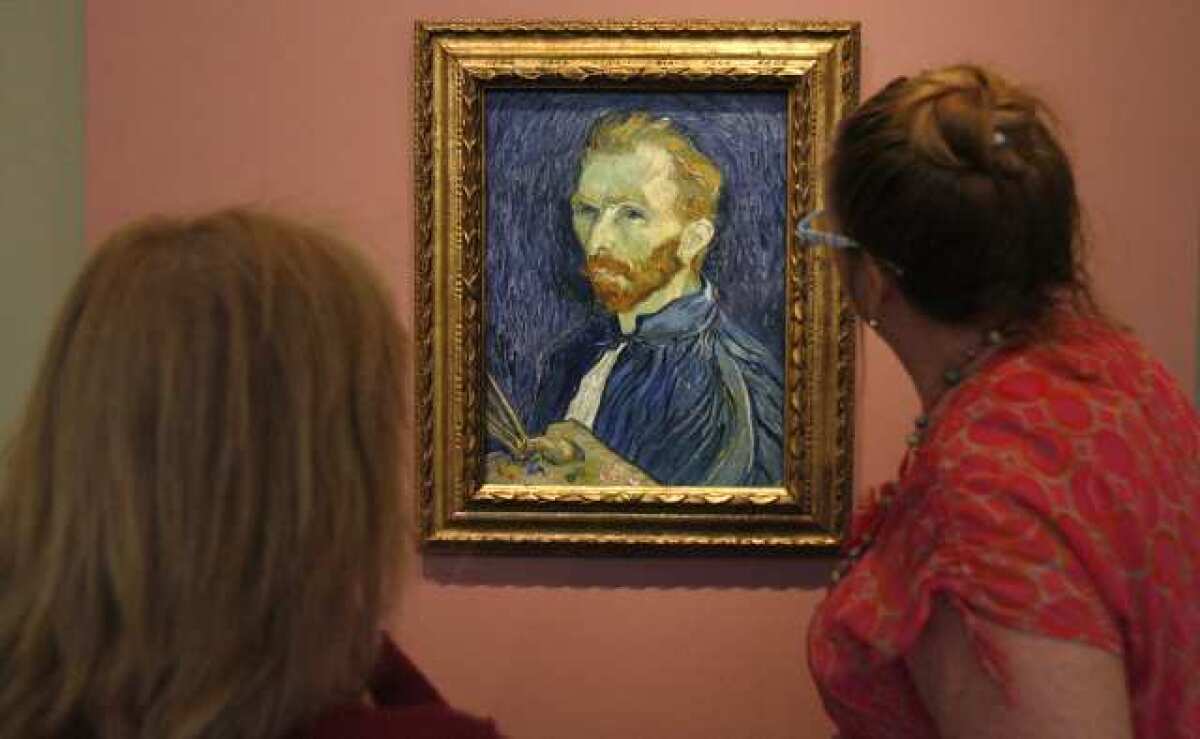The face of Van Gogh

- Share via
During 36 years at the National Gallery of Art, conservator Ann Hoenigswald has learned a few things about Vincent van Gogh. The master impressionist left a wealth of clues about his work and tragic life, which ended by his own hand a century ago at age 37. There are hundreds of letters to his brother, Theo, and a series of vivid, probing self-portraits, including one now on loan to the Norton Simon Museum in Pasadena.
The painting was done in 1889, during the last year of Van Gogh’s life, and depicts the artist as healthy, almost content, posing confidently against a field of blue with his paints at hand. “It really is one of our gems,” says Hoenigswald, who is delivering a lecture on the artist and his work methods March 2 at the Norton Simon called “‘Dear Theo, Thank you for the paints’: Van Gogh’s Choice of Materials and Some Unforeseen Changes.”
Within days afterward, Hoenigswald will oversee the painting’s removal from the wall for the trip back to Washington, D.C., ending its three-month stay in Pasadena. It will be her first lecture at the Norton Simon, but not her first visit.
“It’s one of the most extraordinary museums in the United States,” she says. “It’s small and intimate, and each of the paintings are gems. They don’t have as many Van Goghs as the National Gallery, but what they have are extraordinary.”
What is the significance of this painting?
Hoenigswald: It is one of the most powerful of his self-portraits. This was a very important one to him. He painted it as he was leaving the asylum in Saint-Rémy. He was using it to indicate he was physically, mentally and emotionally in good shape and could go back to painting. It was a test case — proving to himself and to the doctor who had been caring for him that he had recovered and was able to leave the asylum and live again on his own.
Was the impression he tried to give of being healthy untrue or short-lived?
Hoenigswald: He would have seizures that came and went. I’m not going to deny he had problems, but I think he admitted himself to the hospital. He wasn’t committed there. Because he realized he wasn’t stable at that point, but after being at the hospital for a little while, he wanted to prove that he could operate in the real world again. I find it fascinating that he felt that a self-portrait was rather significant. Many of his self-portraits are very compelling and very beautiful, but I think this a very moving picture. It’s beautifully painted.
What will you focus on in your lecture?
Hoenigswald: I’m focusing on the letters between Vincent and his brother Theo. The correspondence is remarkable. There are almost 1,000 letters that he wrote to his brother. He discusses the pigments he wants, the kind of canvases he wants, the color effects he’s trying to achieve. He discusses how many paintings he paints in a certain amount of time, the kind of brushes he’s using. As a conservator and painting restorer, this is the kind of material we rarely find.
Was his distinctive style the result of the materials he used?
Hoenigswald: The materials definitely affected the way his paintings looked. Two things that are most striking are the color — and to Vincent that was key and the only thing that was important about his pictures. But the public today is really drawn to the texture, the handling of the paint and the brushwork. The 19th century colors and the tube paints that were available to artists did have a stiffness to them, which allowed artists to work with more texture. If he had lived 100 years earlier, he wouldn’t have gotten these effects.
Was there a shift in this period from his earlier work?
Hoenigswald: He only was painting for 10 years. He had a very short life, so things happened very quickly with him. Also fascinating with Van Gogh is he paints a lot. Every single day he paints. In the last 70 days of his life, when he lives north of Paris, he paints 70 paintings. That’s remarkable.
The difference between the later pictures and the earlier ones is color. He becomes more comfortable with color. He started painting [with] a very dark palette, and then when he goes to the South of France, it’s all about light. We know from his letters that the pigments he asks for get brighter and brighter. He’s also influenced by Japanese prints, which have very intense colors. He’s picking up on that. At the end of his career, you get these very strong, colorful pictures, and they’re quite in contrast to what he’s doing at the beginning.
Why does Van Gogh generate a special level of interest from the public?
Hoenigswald: His paintings really are unique. Everyone can identify a Van Gogh because of the subject matter, because of the texture and the character of the paint and the brushwork, the energy of them. But we can’t kid ourselves — a lot of it is also the mystique of Van Gogh, this idea of this tragic painter, with this sad life. Because of the letters we know a lot more about him than we do about many artists. There is a familiarity with him. But I like to think it’s really the paintings that draw people.
--
What: Lecture by Ann Hoenigswald, senior conservator of paintings, National Gallery of Art, Washington, D.C., in connection with the ongoing exhibition of Van Gogh’s “Self-Portrait,” 1889
When: March 2, 4 p.m.; lecture is free with admission. Painting on view through March 4
Where: Norton Simon Museum, 411 W. Colorado Blvd., Pasadena
Info: (626) 449-6840, www.nortonsimon.org